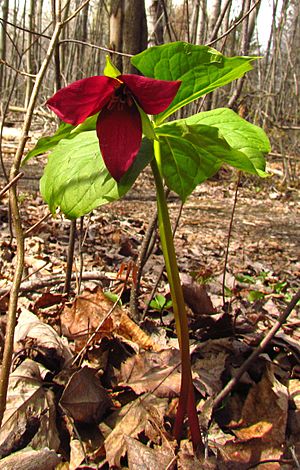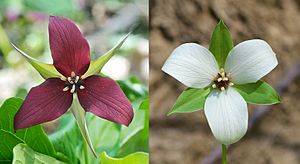Wake robin facts for kids
Quick facts for kids Wake robin |
|
|---|---|
 |
|
| Conservation status | |
| Scientific classification | |
| Genus: |
Trillium
|
| Species: |
erectum
|
| Synonyms | |
|
Synonymy
Trillium pendulum Willd.
Trillium rhomboideum Michx. Trillium foetidum Salisb. Trillium acuminatum Raf. Trillium obovatum Pursh Trillium purpureum Elliott Trillium flavum Raf. Trillium nutans Raf. Trillium spatulatum Raf. Trillium atropurpureum M.A.Curtis ex L.C.Beck Trillium album (Michx.) Small, syn of var. album |
|
The Trillium erectum, also known as the red trillium, is a beautiful flowering plant. People also call it wake robin, purple trillium, bethroot, or stinking Benjamin. It belongs to the Melanthiaceae family.
The name "wake robin" comes from the European robin, a bird with a red chest that signals spring's arrival. Just like the robin, the red trillium is a "spring ephemeral". This means it grows, flowers, and produces seeds early in spring before the trees fully leaf out. It then goes dormant for the rest of the year.
This plant grows naturally in the eastern United States and eastern Canada. You can find it from northern Georgia all the way up to Quebec and New Brunswick.

Contents
What is the Red Trillium?
The Trillium erectum is a perennial plant. This means it lives for more than two years, coming back each spring. It's an herbaceous plant, so it has soft stems, not woody ones like trees.
It usually grows to about 40 centimeters (16 inches) tall and spreads about 30 centimeters (12 inches) wide. This plant is very tough and can handle very cold winters, even temperatures as low as -35 degrees Celsius (-31 degrees Fahrenheit).
Flower and Leaves
Like all trilliums, its parts come in groups of three. It has a flower with three petals sitting above a circle of three pointed leaves. The petals are usually a dark reddish-maroon or purplish color. They might fade to purple as they get older.
Sometimes, you can find red trilliums with yellow, pale green, pink, or white petals. But no matter the petal color, the center part of the flower (called the ovary) is always dark purple to maroon.
How it Attracts Pollinators
The flowers of the red trillium have a smell that some people describe as "carrion-scented." This means it smells a bit like rotting meat. This smell helps attract scavenging flies, which are the main pollinators for this plant. They help the plant make seeds.
After the flower petals wilt, a fruit starts to grow. This fruit ripens into a dark red, berry-like capsule. It's about 1 to 1.5 centimeters (0.4 to 0.6 inches) long.
Different Kinds of Red Trillium
Scientists have noticed that Trillium erectum shares many features with other trillium species in North America. Sometimes, these different species can even mix and create new plants in the wild.
North American Relatives
Here are some other North American trillium species that are closely related to Trillium erectum:
- T. cernuum
- T. erectum
- T. flexipes
- T. rugelii
- T. simile
- T. sulcatum
- T. vaseyi
Varieties of Trillium erectum
There are two main types, or "varieties," of Trillium erectum that scientists recognize:
- Trillium erectum var. album
- Trillium erectum var. erectum
The variety album has white petals. All other petal colors, including yellow, pink, or the typical red, belong to the variety erectum. You can find the white-flowered variety album in different places where the red trillium grows. In some areas, like the western part of North Carolina near the Great Smoky Mountains, the white-flowered type is actually more common, especially at lower elevations.
Growing Red Trillium
Trillium erectum is a popular plant for gardens because of its pretty flowers. It has even received an "Award of Garden Merit" from the Royal Horticultural Society, which means it's a great plant for gardeners to grow.
Traditional Uses
The root of the red trillium was traditionally used by some Native American groups. They made a tea from the root to help with women's health issues and to assist during childbirth. This is why it earned the nickname "Beth root," which comes from "birth root."
It's important to know that the leaves of the red trillium contain tiny crystals called calcium oxalate. These crystals can be harmful if eaten by humans, so the leaves should not be consumed.
Images for kids
-
Trillium erectum var. album in the Great Smoky Mountains National Park (April)




